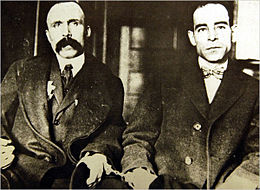A House Divided Over Rittenhouse
Shades of the Sacco and Vanzetti trial of 100 years ago.
Being retired, my wife and I were able to keep the TV tuned all day to the Kyle Rittenhouse trial as we went about our normal activities, stopping what we were doing to pay attention to the proceedings when something important happened in the courtroom.
News coverage and commentary on the trial were just as interesting as the trial itself. Reflecting the political divide in America, the left and right media had opposing takes on the trial—takes that often had little resemblance to the testimonies and evidence in the courtroom.
The left media generally took the side of the rioters, or whom they referred to as demonstrators. According to their narrative, the demonstrators were exercising their First Amendment right and standing up for social justice, even though some of them had criminal records and were the most unjust people imaginable. At the same time, Rittenhouse was characterized as a vigilante or white supremacist.
The right media generally took the side of Rittenhouse, characterizing him as a courageous and clean-cut defender of property who was exercising his Second Amendment right by strutting around with a high-velocity rifle. They characterized the rioters as scruffy anarchists or Marxists.
All of this took place against the backdrop of race, or more accurately, today’s contrived categories of race.
Nothing new here. A similar story happened a century ago, but one in which the establishment media had a perspective that was the opposite of its perspective today. Equally interesting, it’s a story that lays bare the ignorance behind today’s trope that all whites are the same and that only so-called non-whites, or “people of color,” have experienced institutional prejudice and discrimination.
The story is about the Sacco and Vanzetti trial, one of the most infamous trials in American history, a trial that was covered worldwide and that triggered protests around the world when a verdict was reached.
Nicola Sacco and Bartolomeo Vanzetti were poor and poorly educated Italian immigrants who had joined other Italian immigrants in the anarchist movement of the early twentieth century. Based on flimsy evidence, they were indicted for the murder of a guard and paymaster during an April 15, 1920, armed robbery of the Slater and Morrill Shoe Company in Braintree, Massachusetts.
At the time, there was widespread prejudice among the American people and the press against Italians and against swarthy immigrants from Southern Europe in general. (My poor and poorly educated fraternal and maternal grandparents had emigrated from Italy several years before the indictment of Sacco and Vanzetti.)
Bill Bryson captured the thinking of the time in his great book, One Summer:
Often they [Italians] found themselves excluded from employment and educational opportunities because of their nationality. Restrictive covenants kept them from moving into certain neighborhoods. Italians who settled in the Deep South were sometimes made to attend black schools. At first, it was by no means clear that they would be allowed to use white drinking fountains and lavatories . . . The widespread perception of Italians was that if they weren’t Fascists or Bolsheviks, they were anarchists or Communists, and if they weren’t those, they were involved in organized crime.
In keeping with this prejudice, today’s paragon of social justice, the New York Times, editorialized back then that it was “perhaps hopeless to think of civilizing [Italians] or keeping them in order, except by the arm of the law.”
At least Sacco and Vanzetti got a trial, albeit an unfair one, presided over by a brazenly biased judge. By contrast, 11 Italians were lynched in New Orleans without a trial.
On July 14, 1921, with just a few hours of deliberation, a jury convicted the two of first-degree murder, resulting in them being sentenced to death.
Worldwide protests followed. So did petitions from abroad for a retrial. One petition had nearly 500,000 signatures; another had over 150,000. Yet most Americans believed in their guilt, including middle-class Republicans and working-class Irish, who held counterdemonstrations in Boston.
Future Supreme Court justice Felix Frankfurter, who was then a Harvard law professor, wrote an article in the Atlantic Monthly, saying that Sacco and Vanzetti had been railroaded. Many blue-blooded Harvard alumni demanded that Frankfurter be fired and stopped making donations to the university. No doubt, some of their progeny now virtue signal about social justice while continuing to favor some races over others, as will be discussed momentarily.
Seven years after the trial, after a series of appeals, Sacco and Vanzetti were executed in an electric chair.
Today, in an appalling display of institutional amnesia or ignorance of history, many of the same media that had been prejudiced against Sacco and Vanzetti now see themselves as being the epitome of enlightenment about social justice, race, diversity, and multiculturalism. Even more appalling, they have replaced the old prejudice with a new one, aided and abetted by academics and intellectuals, who, given their advanced education, have no excuse for their ignorance.
The new prejudice is that all whites are the same, regardless of ethnicity or nationality or class. They are all part of a homogenous blob. The only exceptions are Latinos, although many of them are whiter than this writer and come from privileged backgrounds.
According to the new prejudice, all whites but Latinos are privileged, all have benefited in a zero-sum game at the expense of non-whites, all harbor conscious or unconscious racist feelings, and all share the responsibility for slavery and its legacy, for the genocide of Native Americans, for the Chinese Exclusion Act, and for the mistreatment of Mexicans in the American Southwest.
Those labeled as white are guilty of these sins even if their forebears were peasants in the old country when the sinning happened, and even if they are from one of the hundreds of ethno-cultural groups that are far removed in history, culture, and skin shade from the nation’s founding white Anglo-Saxon Protestants.
The new prejudice has led to discrimination in employment at the hands of directors of diversity and inclusion, as well as to ugly stereotyping in K-16 education, in the form of critical race theory, which is based on convoluted thinking instead of critical thinking.
To take one example, a Latino American can get extra college admission points or promotion points in industry by virtue of his ethnicity and surname, even if his forebears were members of the Spanish aristocracy and owned slaves. But a Walloon American, or someone named Vanzetti, gets no extra points, even if his forebears were impoverished and didn’t own slaves.
In summary, America is still a house divided. It will remain so as long as new prejudices are allowed to replace old ones.



